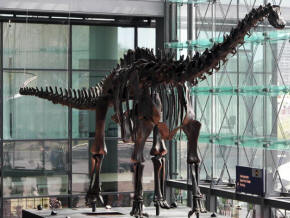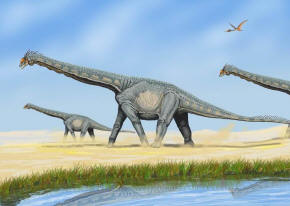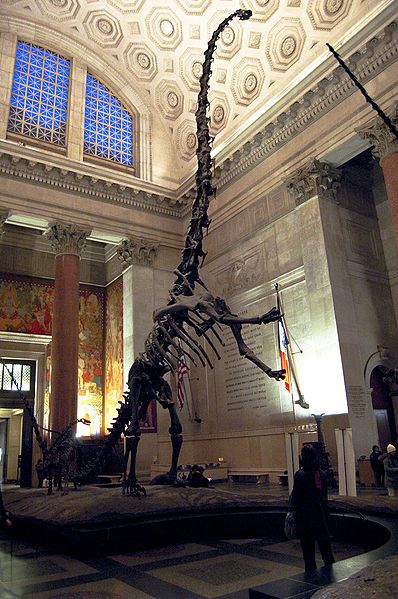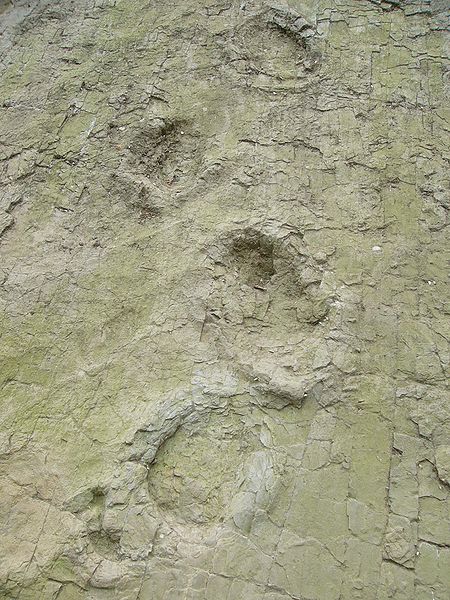|
Complete sauropod fossil finds are rare. Many species,
especially the largest, are known only from isolated and disarticulated
bones. Many near-complete specimens lack heads, tail tips and limbs.
Description
Sauropods were herbivorous, usually quite long-necked quadrupeds
(four-legged), often with spatulate (spatula-shaped: broad at the base,
narrow at the neck) teeth. They had tiny heads, massive bodies, and tended
to have long tails. Their hind legs were thick, straight, and powerful,
ending in club-like feet with five toes, though only the inner three (or in
some cases four) bore claws. Their forelimbs were rather more slender and
ended in pillar-like hands built for supporting weight; only the thumb bore
a claw. Many illustrations of sauropods in the flesh miss these facts,
inaccurately depicting sauropods with hooves capping the claw-less digits of
the feet, and/or multiple claws or hooves on the hands. The proximal caudal
vertebrae is extremely diagnostic for sauropods.
Size
The sauropods' most defining
characteristic was their size. Even the dwarf sauropods like Europasaurus (perhaps 5 to 6 meters,
or 20 feet
long) were counted among the largest animals in their
ecosystem. Their only real competitors in
terms of size are the
rorqual
whales, such as the
Blue Whale. But unlike
whales, sauropods were primarily land-based animals.
Their body design did not vary as
much as other dinosaurs, perhaps due to size constraints, but they still
displayed ample variety. Some, like the diplodocids, possessed tremendously
long tails which they may have been able to crack like a whip
to deter or even injure predators,
or to make
sonic booms.
Supersaurus, at 33 to 34 metres (108 to 112
ft) long,
is the longest sauropod known from reasonably complete remains, but others,
like the old record holder,
Diplodocus, are still extremely long. The
holotype (and now lost) vertebra of
Amphicoelias fragillimus
may have come from an animal 58 metres (190 ft) long;
its vertebral column would have been substantially longer than that of the
blue whale. The longest terrestrial animal alive today, the
reticulated python,
only reaches lengths of 8.7 metres (29 ft).
Others, like the brachiosaurids, were
extremely tall, with high shoulders and extremely long necks.
Sauroposeidon is probably the tallest,
reaching about 18 metres (60 ft) high, with the previous record for longest
neck being held by
Mamenchisaurus. By comparison the giraffe,
the tallest of all living animals, is only 4.8 to 5.5 metres (16 to 18 ft)
tall.
Some were almost incredibly massive:
Argentinosaurus is
probably the heaviest at 80 to 100 metric
tonnes (90 to 110 tons),
though
Paralititan,
Andesaurus,
Antarctosaurus, and
Argyrosaurus are of comparable sizes. There
is some very poor evidence of an even more massive titanosaurian,
Bruhathkayosaurus,
which might have weighed between 175 to 220 tonnes (190 to 240 tons). The
largest land animal alive today, the Savannah
elephant, weighs no more than 10 metric tons
(11 short tons).
Among the smallest sauropods were
the primitive
Ohmdenosaurus (4 m, or
13 ft long), the dwarf
titanosaur
Magyarosaurus (5.3 m
or 17 ft long), and the dwarf brachiosaurid
Europasaurus, which was 6.2 meters long as a
fully-grown adult.
Its small stature was probably the result of
insular dwarfism of a
herd of sauropods stranded on an island in what is now Germany.
Also notable is the diplodocoid sauropod
Brachytrachelopan,
which was the shortest member of its group thanks to its unusually short
neck. Unlike other sauropods, whose necks could grow to up to four times the
length of their backs, the neck of
Brachytrachelopan was shorter than its backbone.
Limbs and feet
As massive quadrupeds, sauropods
developed specialized graviportal
(weight-bearing) limbs. The hind feet were broad, and retained three claws
in most species.
Particularly unusual compared with other animals were the highly modified
front feet (manus).
The front feet of sauropods were very dissimilar from those of modern large
quadrupeds such as elephants. Rather than
splaying out to the sides to create a wide foot as in elephants, the manus
bones of sauropods were arranged in fully vertical columns, with extremely
reduced finger bones (though it is not clear if the most primitive
sauropods, such as
Vulcanodon and
Barapasaurus, had such forefeet).
The front feet were so modified in
eusauropods that
individual digits would not have been visible in life.
The arrangement of the forefoot bone
(metacarpal)
columns in eusauropods was semi-circular, so sauropod forefoot prints are
horseshoe-shaped. Unlike elephants, print evidence shows that sauropods
lacked any fleshy padding to back the front feet, making them concave.
The only claw visible in most sauropods was the distinctive thumb claw
(associated with digit I). Almost all sauropods had such a claw, though what
purpose it served is unknown. The claw was largest (as well as tall and
laterally flattened) in diplodocids, and very small in brachiosaurids, some
of which seem to have lost the claw entirely based on trackway evidence.
Titanosaurs may have lost the thumb
claw completely (with the exception of early forms such as
Janenschia). Titanosaurs were most unusual
among sauropods, as in addition to the external claw, they completely lost
the digits of the front foot. Advanced titanosaurs had no digits or digit
bones, and walked only on horseshoe-shaped "stumps" made up of the columnar
metacarpal bones.
Print evidence from
Portugal shows that in at least some
sauropods (probably brachiosaurids), the bottom and sides of the forefoot
column was likely covered in small, spiny scales, which left score marks in
the prints.
In titanosaurs, the ends of the metacarpal bones that contacted the ground
were unusually broad and squared-off, and some specimens preserve the
remains of soft tissue covering this area, suggesting that the front feet
were rimmed with some kind of padding in these species.
Matthew Bonnan
has shown that sauropod dinosaur long bones grew isometrically: that is,
there was little to no change in shape as juvenile sauropods became gigantic
adults. Bonnan suggested that this odd scaling pattern (most vertebrates
shown significant shape changes in long bones associated with increasing
weight support) might be related to a stilt-walker principle (suggested by
amateur scientist Jim Schmidt) in which the long legs of adult sauropods
allowed them to easily cover great distances without changing their overall
mechanics.
Tail
The book version of
Walking with Dinosaurs
expresses a theory that
Diplodocus could crack its tail like a
stockwhip to make a
loud noise for communication.
Air sacs
Along with other
saurischian dinosaurs
(such birds and other theropods), sauropods had a system of air sacs,
evidenced by indentations and hollow cavities in most of their vertebrae.
Pneumatic, hollow bones
are a characteristic feature of all sauropods.
The bird-like hollowing of sauropod
bones was recognized early in the study of these animals, and in fact at
least one sauropod specimen found in the 19th century (Ornithopsis)
was originally misidentified as a
pterosaur (a flying reptile) because of
this.
Armor
Some sauropods had armor. There were
genera with spined backs, such as
Agustinia, and some
had small clubs on their tails,
like
Shunosaurus. Several
titanosaurs, such as
Saltasaurus and
Ampelosaurus, had small bony
osteoderms covering
portions of their bodies.
Palaeobiology
Herding and parental care
Many lines of fossil evidence, from
both bone beds and trackways, indicate that sauropods were gregarious
animals that formed herds. However, the
makeup of the herds varied between species. Some bone beds, for example a
site from the Middle Jurassic of
Argentina, appear to show herds made up of
individuals of various age groups, mixing juveniles and adults. However, a
number of other fossil sites and trackways indicate that many sauropod
species travelled in herds segregated by age, with juveniles forming herds
separate from adults. Such segregated herding strategies have been found in
species such as
Alamosaurus,
Bellusaurus, and some
diplodocids.
In a review of the evidence for various herd types, Myers
and Fiorillo attempted to explain why sauropods appear to have often formed
segregated herds. Studies of microscopic tooth wear show that juvenile
sauropods had diets that differed from their adult counterparts. Differing
tooth wear suggests that juveniles had different feeding strategies than
adults, so herding together would not have been as productive as herding
separately, where individual herd members could forage in a coordinated way.
The vast size difference between juveniles and adults may also have played a
part in the different feeding and herding strategies.
Since the segregation of juveniles
and adults must have taken place soon after hatching, Myers and Fiorillo
concluded that species with age-segregated herds could not have exhibited
much parental care, if any.
On the other hand, scientists who have studied age-mixed sauropod herds
suggested that these species may have cared for their young for an extended
period of time before the young reached adulthood.
Exactly how segregated versus age-mixed herding varied
across different groups of sauropods is unknown. Further examples of
gregarious behavior will need to be discovered from more sauropod species to
begin detecting possible patterns of distribution.
Rearing stance
Since early in the history of their
study, scientists such as
Osborn have speculated
that sauropods could rear up on their hind legs, using the tail as the third
'leg' of a tripod.
A skeletal mount depicting the
diplodocid
Barosaurus lentus
rearing up on its hind legs at the
American Museum of Natural History
is one illustration of this hypothesis. In a 2005 paper, Rothschild and
Molnar reasoned that if sauropods had adopted a bipedal posture at times,
there would be evidence of stress fractures in the forelimb 'hands'.
However, none were found after they examined a large number of sauropod
skeletons.
Heinrich Mallison (in 2009) was the
first to study the physical potential for various sauropods to rear into a
tripodal stance. Mallison found that some characters previously linked to
rearing adaptations were actually unrelated (such as the wide-set hip bones
of
titanosaurs) or would
actually have hindered rearing. For example, titanosaurs had an unusually
flexible backbone, which would have decreased stability in a tripodal
posture and would have put more strain on the muscles. Likewise, it is
unlikely that brachiosaurids could rear up onto the hind legs, given their
center of gravity was much farther forward than other sauropods, which would
cause such a stance to be unstable.
Diplodocids, on the other hand,
appear to have been well adapted for rearing up into a tripodal stance.
Diplodocids had a center of mass directly over the hips, giving them greater
balance on two legs. Diplodocids also had the most mobile necks of
sauropods, a well-muscled pelvic girdle, and tail vertebrae with a
specialised shape that would allow the tail to bear weight at the point it
contacted the ground. Mallison concluded that diplodocids were better
adapted to rearing than elephants, which do so
occasionally in the wild. He also argues that stress fractures in the wild
do not occur from everyday behaviour,
such as feeding-related activities (contra Rothschild and Molnar).Head
and neck posture
There is controversy over whether
sauropods held their heads near vertically or horizontally. The claim that
the long necks of sauropods were used for browsing high trees has been
questioned on the basis of calculations of the energy needed to create the
arterial blood pressure for the head if it was held upright. These
calculations suggest this would have taken up roughly half of its energy
intake.
Further, to supply blood to the head vertically held high would have
required blood pressure of around 700 mmHg at the heart. This would have
required that their hearts were 15 times the size of whales of similar size.
This suggests it was more likely the long neck was usually held horizontally
to enable them to feed on plants over a very wide area without needing to
move their bodies—a potentially large saving in energy for 30 to 40 ton
animals. In support of this, reconstructions of the necks of
Diplodocus and
Apatosaurus show that they
are basically straight with a gentle decline orientating their heads in a
"neutral, undeflected posture" when close to ground.
However, research on living animals
has suggested that sauropod heads were held in an upright S-shaped curve.
Inference from bones about "neutral head postures" which suggest a
horizontal position
may be unreliable, according to this research. If applied to living animals
it would imply they also held their heads in this position, even though they
in fact do not.
Trackways and Locomotion
Sauropod
trackways and other
fossil footprints
(known as "ichnites") are known from abundant evidence present on most
continents. Ichnites have helped support other biological hypotheses about
sauropods, including general fore and hind foot anatomy (see
Limbs and feet above).
Generally, prints from the forefeet are much smaller than the hind feet, and
often crescent-shaped. Occasionally ichnites preserve traces of the claws,
and help confirm which sauropod groups lost claws or even digits on their
forefeet.
Generally, sauropod trackways are
divided into three categories based on the distance between opposite limbs:
narrow gauge, medium gauge, and wide gauge. The gauge of the trackway can
help determine how wide-set the limbs of various sauropods were and how this
may have impacted the way they walked.
A 2004 study by Day and colleagues found that a general pattern could be
found among groups of advanced sauropods, with each sauropod family being
characterised by certain trackway gauges. They found that most sauropods
other than
titanosaurs had
narrow-gauge limbs, with strong impressions of the large thumb claw on the
forefeet. Medium gauge trackways with claw impressions on the forefeet
probably belong to brachiosaurids and other primitive
titanosauriformes,
which were evolving wider-set limbs but retained their claws. Primitive true
titanosaurs also retained their forefoot claw but had evolved fully wide
gauge limbs. Wide gauge limbs were retained by advanced titanosaurs,
trackways from which show a wide gauge and lack of any claws or digits on
the forefeet.
Size evolution
Several scientists have attempted to
address the question of why sauropods attained such huge sizes. Gigantic
sizes were reached early in sauropod evolution, going back to the first true
sauropods in the late
Triassic Period. According to
Kenneth Carpenter,
whatever evolutionary pressure caused large size must have therefore been
present from the early origins of the group.
Studies of
mammalian herbivores
that attained large size, such as elephants, have found
that larger size in plant-eating animals leads to greater efficiency in
digesting food. Since larger animals have longer digestive systems, food is
kept in digestion for significantly longer periods of time, allowing large
animals to survive on lower-quality food sources. This is especially true of
animals with a large number of 'fermentation chambers' along the intestine
which allow microbes to accumulate and ferment plant material, aiding
digestion. Throughout their evolutionary history, sauropod dinosaurs were
found primarily in semi-arid, seasonally dry environments, with a
corresponding seasonal drop in the quality of food during the dry season.
The environment of most gigantic Late Jurassic sauropods such as
Amphicoelias was essentially a
savanna,
similar to the arid environments in which modern giant herbivores are found,
supporting the idea that poor-quality food in an arid environment promotes
the evolution of giant herbivores. Carpenter argued that other benefits of
large size, such as relative immunity from predators, lower energy
expenditure, and longer life span, were probably secondary advantages, and
that sauropods attained large size primarily to help process food more
efficiently.
History of
discovery
The first scrappy fossil remains now
recognized as sauropods all came from
England
and were originally interpreted in a variety of different ways. Their
relationship to other dinosaurs was not recognized until well after their
initial discovery.
The first sauropod fossil to be
scientifically described was a single tooth known by the non-Linnaean
descriptor
Rutellum implicatum.
This fossil was described by
Edward Lhuyd in 1699, but was not recognized
as a giant prehistoric reptile at the time.
Dinosaurs would not be recognized as a group until over a century later.
Richard Owen published
the first modern scientific description of sauropods in 1841, in his paper
naming
Cetiosaurus and
Cardiodon.
Cardiodon was known only from a two unusual,
heart-shaped teeth (from which it got its name), which could not be
identified beyond the fact that they came from a previously unknown large
reptile.
Cetiosaurus was known from slightly better, but
still scrappy remains. Owen thought at the time that
Cetiosaurus was a giant
marine reptile related to modern crocodiles, hence its
name, which means "whale lizard". A year later, when Owen coined the name
Dinosauria, he did not include
Cetiosaurus
and Cardiodon in
that group.
In 1850,
Gideon Mantell recognized the dinosaurian
nature of several bones assigned to Cetiosaurus
by Owen. Mantell noticed that the leg bones contained a
medullary cavity, a
characteristic of land animals. He assigned these specimens to the new
genus
Pelorosaurus, and
grouped it together with the dinosaurs. However, Mantell still did not
recognize the relationship to Cetiosaurus.
The next sauropod find to be
described and misidentified as something other than a dinosaur were a set of
hip vertebrae described by
Harry Seeley in 1870. Seeley found that the
vertebrae were very lightly constructed for their size and contained
openings for
air sacs (pneumatization).
Such air sacs were at the time known only in birds and pterosaurs, and Seeley
considered the vertebrae to come from a pterosaur. He named the new genus
Ornithopsis, or "bird
face" because of this.
When more complete specimens of Cetiosaurus were
described by Phillips in 1871, he finally recognized the animal as a
dinosaur related to Pelorosaurus.
However, it was not until the description of new, nearly complete sauropod
skeletons from the
United States (representing
Apatosaurus and
Camarasaurus) later that year that a
complete picture of sauropods emerged. An approximate reconstruction of a
complete sauropod skeleton was produced by John A. Ryder, based on the
remains of Camarasaurus,
though many features were still inaccurate or incomplete according to later
finds and biomechanical studies. Also in 1877,
Richard Lydekker named
another relative of Cetiosaurus,
Titanosaurus, based on
an isolated vertebra.
In 1878, the most complete sauropod
yet was found and described by
Othniel Charles Marsh,
who named it
Diplodocus. With this
find, Marsh also created a new group to contain
Diplodocus,
Cetiosaurus, and their
increasing roster of relatives to differentiate them from the other major
groups of dinosaurs. Marsh named this group Sauropoda, or "lizard feet".
Return to the
Old Earth Ministries Online Dinosaur
Curriculum homepage.

|




